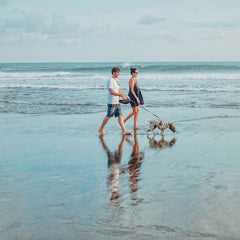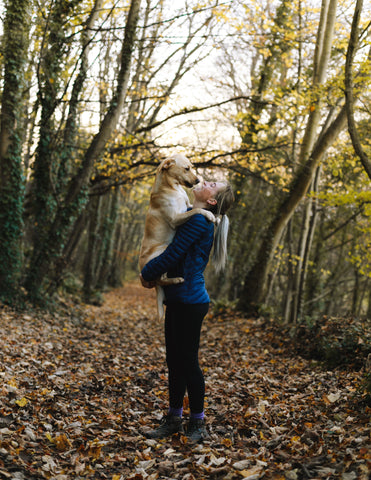Helpful Dog Walking Tips for Safer Travels
How can I improve walks with my dog?

Photo by Roman Bintang on Unsplash
Walking your dog is one of life’s pleasures. With the right training and preparation, you and your dog can enjoy every walk you take together.
Have a look at some helpful dog walking tips to make life easier for you both.
Safety first
Always keep your safety, your dog’s safety and the safety of others in mind when you are walking your dog.
A good dog lead is the first step. To begin with, dog leads are a legal requirement in Australia. Unless your dog is in a designated off-leash zone, it must be on a lead when out in public.
Beyond the law, a lead gives you control over your pet. Even the most well-trained dogs are capable of slip-ups in behaviour, especially if they spot something too exciting to ignore. What’s more, you don’t want your dog to run into traffic or towards another hazard because he or she is not restrained.
Once you have a proper lead (more on this shortly), you will need to think about where and when you walk your dog.
Quiet places with little traffic and plenty of nature are ideal, but these are not available to everyone. If you live in a bustling city, you might consider walking your dog early in the morning or later in the evening when traffic is at a minimum.
Walking your dog after dark? A reflective collar or coat for your dog will help improve safety.
Dog walking tips: consider the crowds
Walking your dog at quieter times can be about more than just traffic.
If your dog does not socialise well, either because they are too timid or too aggressive, walking them when there are fewer people and other dogs around can be a good idea. The same applies to walking in dog parks and other dog-friendly areas. Dogs who startle easily or get overexcited may benefit from a very early or late play at these places.
This may make life a little difficult so consider investing in training that will help your dog understand how to behave around other puppy pals.
Another tip you can try is a bandana around your dog’s neck. People use these to indicate if they have a shy or antisocial dog. Instead of having to explain your dog’s nature to passers-by who want a pat, you can make it clear and obvious that you are not able to stop.
If you arrive at a park and another dog is out of control, while it’s not fair, the best thing to do is move on and find somewhere else to walk or play. It’s not worth putting your dog at risk.
Be tick-safe
If you and your pet are walking in a bushy area, there may be ticks present. Check your dog for ticks when you return home and remember to talk about tick prevention options with your vet.
Be water-wise
Dogs will get thirsty on a long walk. You could try taking a collapsible dog bowl and fill it from your water bottle or a tap at the park so your pet does not become dehydrated. This will reduce the likelihood of your dog stopping to drink dirty water.

Photo by Humphrey Muleba on Unsplash
Which dog lead is best?
As many dog owners know, an enthusiastic pup can be as much of a problem as a shy or aggressive one when it comes to walks or playing at the park.
If your pet pulls at the lead or won’t take another cue from you to stay calm, you could try a slip lead. These leads have a ring set at the nape of the neck that tightens when the dog pulls. As soon as the dog relaxes and walks by your side, they won’t feel any pressure from this lead.
There has been some debate about the use of slip leads but they do serve a purpose. In general, a slip lead is best for especially rambunctious pups who need help to stay focused. Check out Charlie’s story on trucharlie.com.au for a good example of slip lead use.
Don’t confuse a slip leash with a choke chain. Slip leads are softer and set higher on the neck so they don’t restrict your dog’s breathing. You may find a slip lead is helpful when walking your dog as it will help them remember to heel. Check out our range at www.truecharlie.com.au
An alternative to a slip lead is a harness. This fits around your dog’s chest and the lead clips to the harness, either at the front between their shoulders or at the back behind their neck. Some dog owners find a harness causes their dog to pull even more, while others use them without any issues.
One more option is a retractable lead which allows you to control how far ahead of you your dog can walk. A retractable lead gives a calm dog extra freedom to explore but can be problematic if your dog is a fast mover because they get tangled easily.
Dog lead use
When walking your dog, it is ideal to have your dog walking by your side or slightly behind you on a reasonably short lead. This gives you more control and a better chance of stopping your pooch from dashing off.
Follow the rules
A final dog walking tip is to follow the rules of your area.
Keep your dog leashed where you should and pick up after him. Don’t take dogs into bushland where they are not welcome or where there may be poison laid for non-native pests like foxes.
Be conscious of others and courteous to their needs.
Finally, take a ball or dog toy to throw in an off-lead zone so your dog can make the most of being outside. They will love to be able to play with you and be tired enough to relax quietly once you get home.
You may find a slip lead is helpful when walking your dog. Check out our range at www.truecharlie.com.au.
